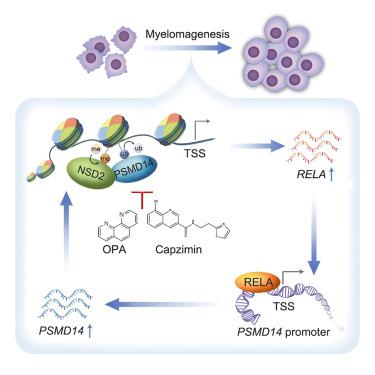Molecular Cell ( IF 14.5 ) Pub Date : 2023-11-06 , DOI: 10.1016/j.molcel.2023.10.019
Lin He 1 , Chunyu Yu 2 , Sen Qin 3 , Enrun Zheng 3 , Xinhua Liu 2 , Yanhua Liu 1 , Shimiao Yu 3 , Yang Liu 4 , Xuelin Dou 4 , Zesen Shang 5 , Yizhou Wang 3 , Yue Wang 6 , Xuehong Zhou 3 , Boning Liu 4 , Yuping Zhong 7 , Zhiqiang Liu 8 , Jin Lu 4 , Luyang Sun 1

|
While 19S proteasome regulatory particle (RP) inhibition is a promising new avenue for treating bortezomib-resistant myeloma, the anti-tumor impact of inhibiting 19S RP component PSMD14 could not be explained by a selective inhibition of proteasomal activity. Here, we report that PSMD14 interacts with NSD2 on chromatin, independent of 19S RP. Functionally, PSMD14 acts as a histone H2AK119 deubiquitinase, facilitating NSD2-directed H3K36 dimethylation. Integrative genomic and epigenomic analyses revealed the functional coordination of PSMD14 and NSD2 in transcriptional activation of target genes (e.g., RELA) linked to myelomagenesis. Reciprocally, RELA transactivates PSMD14, forming a PSMD14/NSD2-RELA positive feedback loop. Remarkably, PSMD14 inhibitors enhance bortezomib sensitivity and fosters anti-myeloma synergy. PSMD14 expression is elevated in myeloma and inversely correlated with overall survival. Our study uncovers an unappreciated function of PSMD14 as an epigenetic regulator and a myeloma driver, supporting the pursuit of PSMD14 as a therapeutic target to overcome the treatment limitation of myeloma.
中文翻译:

蛋白酶体成分 PSMD14 通过组蛋白去泛素酶活性驱动骨髓瘤发生
虽然 19S蛋白酶体调节颗粒 (RP) 抑制是治疗硼替佐米耐药性骨髓瘤的一种有前途的新途径,但抑制19S RP 成分 PSMD14的抗肿瘤作用不能用选择性抑制蛋白酶体活性来解释。在这里,我们报告 PSMD14 与染色质上的 NSD2 相互作用,不依赖于 19 S RP。从功能上讲,PSMD14 充当组蛋白 H2AK119 去泛素酶,促进 NSD2 指导的 H3K36 二甲基化。综合基因组和表观基因组分析揭示了 PSMD14 和 NSD2 在与骨髓瘤发生相关的靶基因(例如RELA )转录激活中的功能协调。相反,RELA 反式激活PSMD14,形成 PSMD14/NSD2-RELA 正反馈回路。值得注意的是,PSMD14 抑制剂可增强硼替佐米的敏感性并促进抗骨髓瘤的协同作用。PSMD14表达在骨髓瘤中升高,并且与总生存率呈负相关。我们的研究揭示了 PSMD14 作为表观遗传调节剂和骨髓瘤驱动因素的未被认识到的功能,支持将 PSMD14 作为治疗靶点来克服骨髓瘤的治疗局限性。































 京公网安备 11010802027423号
京公网安备 11010802027423号